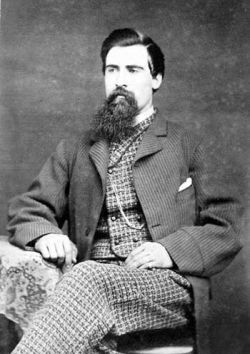The Civil War is a story of both events and individual persons. Among the soldiers of the United States Army is Thomas L. Magee, born in Cambridge, Guernsey County, Ohio in 1836, and raised in Peoria County, Illinois. At the age of thirteen, Magee accepted Christ in a Baptist church. In his young adult years, Thomas studied medicine at Rush Medical College of Chicago and in Nashville, but was unable to finish his studies by the time the war began.
Today, Magee is mustered into the Fifty-First Illinois, and–incomplete medical studies notwithstanding–is commissioned as second assistant surgeon. As the year draws to a close, his mettle is tested in the Battle of Stone’s River (December 31 – January 2), during which Confederate forces capture the Fifty-First’s medical supplies. Magee’s black bag is lost, and he is forced to treat the wounded with little resources at his disposal.
In the months following, Magee is assigned to Nashville’s military hospitals, and afterwards is appointed full surgeon of the Fifty-First on May 28, 1863. Then comes the Battle of Chickamauga, September 19-20, 1863. A biographical sketch of his life tells what happens next.
The Fifty-First Illinois engaged enemies at the Battle of Chickamauga at 4:00 p. m. Within an hour the regiment had more than a hundred casualties. Magee, hospital stewards, regimental musicians, and men who were ill but still walking carried the wounded from the field and tended them behind the lines west of the fields of fighting. Magee worked through the night at the division hospital south of the battlefield at Crawfish Springs. The fighting started again on the morning of the 20th. The shrinking Federal right wing was driven from the field. The partially exposed division hospitals at Crawfish Springs were soon completely exposed. There was a mad rush to evacuate the Federal hospitals; the ambulatory and everyone who could be moved were loaded into ambulances and started off for safer zones. At four in the afternoon, Confederate cavalry took the Federal hospitals. Magee was one of the surgeons who stayed behind with the wounded who could not be moved. He was captured with other physicians, hospital stewards, wounded men, dying men, rations, stores, and hospital supplies. For over a week he tended to the wounded on the Chickamauga field as the Confederates prepared to send their captives off to Richmond or, if they were badly wounded, back across the lines as paroled prisoners. Magee wrote later, “Our supply of rations was only sufficient to last to the fourth day of our capture, when we had to resort to the use of boiled wheat, stored in the building we occupied; and this was the only thing between us and starvation.” The men shared tin cups and iron spoons to eat the gruel (Higginson, p. 136). At the very end of September or beginning of October Magee, with his wounded walking charges, marched to Dalton, Georgia and then took the railroad to Atlanta and soon thereafter to Richmond. Magee was imprisoned at Libby Prison in Richmond until November 24, 1863 at which time there was an exchange of physicians, and Magee was “sent north”.
Back with the army, Magee served on, not only with the Fifty-First but he was soon promoted to brigade and division surgeon duties—and worked through the 1864 Georgia campaign and then back into Tennessee in November and December 1864 in the effort to thwart John Bell Hood, then finally to New Orleans and Texas. He closed his records with the Federal Medical Department in October, 1865, several weeks after the regiment had been mustered out, left Texas, and gone home.
After the war, Thomas Magee moves back to Illinois to practice medicine, marries Sarah E. Sanford, and raises three sons. In 1883 the Magee family moves to California, where Thomas becomes a “prominent physician” in San Diego. As is later written of the physician, regarding his life and accomplishments in both Illinois and California:
Politically Dr. Magee is a stanch republican. While a resident of Prairie City, Illinois, he served for two years as president of the board of trustees, and for four years he was a member of the board of education. Since a youth of thirteen he has been identified with the Baptist church and for the past quarter of a century has served as deacon of the First Baptist church of San Diego. He is likewise a worthy exemplar of the Masonic fraternity and for eight years served as master of Golden Gate Lodge, No. 248, of Prairie City, Illinois. He was also assistant lecturer of the grand lodge of Illinois. In Grand Army circles he is well known and honored, being past commander of Heintzelmann Post of San Diego and also past commander of D. C. Coon Post of this city. Always approachable and kindly, he is animated by a deep and helpful interest in his fellowmen and is ever willing to encourage and assist those who are working toward higher ideals.
Sarah Magee dies in 1904, and Thomas in 1929, in his nineties.
Sources: “Thomas L. Magee, Surgeon, Fifty-First Illinois Infantry,” including photo (link); Samuel T. Black, San Diego County, California: A Record of Settlement, Organization, Progress and Achievement, Chicago: S. J. Clarke, 1913, pp. 54-55 (link)



